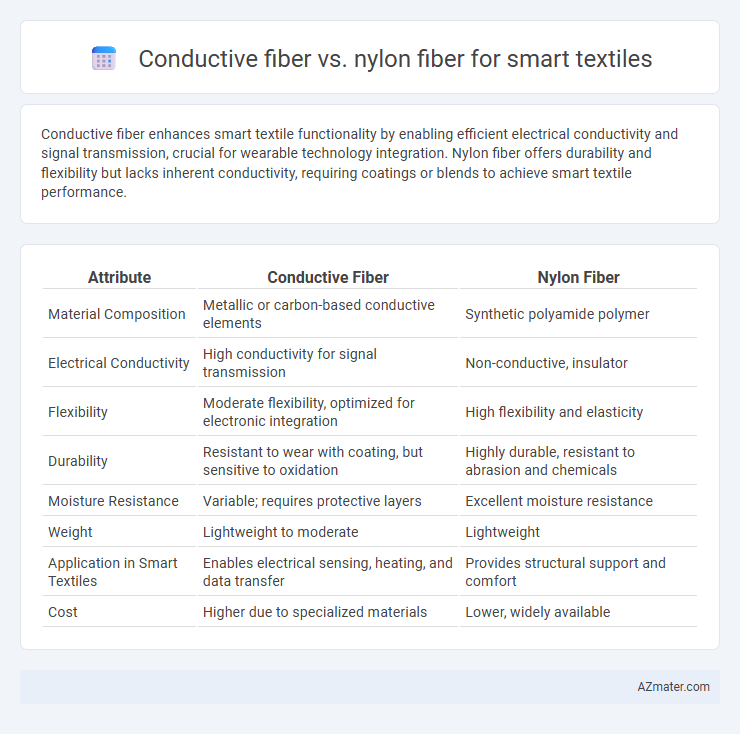Conductive fiber enhances smart textile functionality by enabling efficient electrical conductivity and signal transmission, crucial for wearable technology integration. Nylon fiber offers durability and flexibility but lacks inherent conductivity, requiring coatings or blends to achieve smart textile performance.
Table of Comparison
| Attribute | Conductive Fiber | Nylon Fiber |
|---|---|---|
| Material Composition | Metallic or carbon-based conductive elements | Synthetic polyamide polymer |
| Electrical Conductivity | High conductivity for signal transmission | Non-conductive, insulator |
| Flexibility | Moderate flexibility, optimized for electronic integration | High flexibility and elasticity |
| Durability | Resistant to wear with coating, but sensitive to oxidation | Highly durable, resistant to abrasion and chemicals |
| Moisture Resistance | Variable; requires protective layers | Excellent moisture resistance |
| Weight | Lightweight to moderate | Lightweight |
| Application in Smart Textiles | Enables electrical sensing, heating, and data transfer | Provides structural support and comfort |
| Cost | Higher due to specialized materials | Lower, widely available |
Introduction to Smart Textiles
Smart textiles integrate advanced materials like conductive fibers and nylon fibers to create interactive fabrics with sensing, heating, or communication capabilities. Conductive fibers enable electrical conductivity essential for data transmission and power supply, while nylon fibers provide durability, flexibility, and comfort to the textile structure. Combining these fibers optimizes performance in wearable technology, medical devices, and responsive clothing applications.
Overview of Conductive Fibers
Conductive fibers are engineered materials designed to carry electrical signals or currents, often composed of metals like silver, copper, or carbon-based substances integrated into textile structures. These fibers enable smart textiles to monitor physiological conditions, provide heating, or facilitate communication, surpassing the insulating properties of traditional nylon fibers. Their integration enhances the functionality of wearable technology by combining flexibility, durability, and electrical conductivity essential for advanced textile applications.
Overview of Nylon Fibers
Nylon fibers, a synthetic polymer known for their high strength, elasticity, and abrasion resistance, serve as a foundational material in smart textiles due to their durability and lightweight properties. Unlike conductive fibers that enable electrical conductivity for sensing and data transmission, nylon fibers primarily provide structural support and comfort, making them ideal for wearable technology applications where flexibility and resilience are crucial. Their moisture-wicking ability and resistance to chemicals enhance the performance and longevity of smart textile products incorporating nylon fiber blends.
Electrical Properties Comparison
Conductive fibers, such as silver-coated or carbon-based fibers, exhibit significantly higher electrical conductivity compared to nylon fibers, which are inherently insulating. Conductive fibers enable efficient signal transmission and sensing capabilities critical for smart textile applications, whereas nylon fibers require additional treatments or coatings to achieve conductivity. The superior electrical properties of conductive fibers facilitate better performance in wearable electronics, energy harvesting, and health monitoring systems integrated into smart textiles.
Mechanical Strength and Durability
Conductive fibers, often made from materials like silver-coated nylon or stainless steel, exhibit superior mechanical strength and enhanced durability compared to standard nylon fibers, making them more suitable for smart textile applications that require consistent electrical performance under mechanical stress. Nylon fibers offer good tensile strength and elasticity but tend to degrade faster under repeated bending and washing, reducing the lifespan of smart garments. Incorporating conductive fibers in smart textiles ensures long-term durability and reliable conductivity, critical for wearable sensors and electronic textiles exposed to dynamic movements and environmental factors.
Flexibility and Comfort in Wearables
Conductive fibers offer superior flexibility by integrating seamlessly with fabric structures, enabling wearable smart textiles to maintain natural movement without stiffness. Nylon fibers provide excellent softness and breathability, enhancing overall comfort but lack inherent electrical conductivity. Combining conductive fibers with nylon can optimize both flexibility and comfort, crucial for long-term wearable applications that require reliable sensing and user-friendly wearability.
Integration with Electronic Components
Conductive fibers such as silver-plated or copper-coated yarns provide superior electrical conductivity and seamless integration with electronic components, enabling reliable data transfer and sensor functionality in smart textiles. Nylon fibers, while durable and flexible, require additional coatings or treatments to achieve conductive properties, which can compromise their mechanical integrity and hinder stable electronic interfacing. Smart textile applications prioritize conductive fibers for embedding sensors, LEDs, and circuits due to their consistent conductivity and ease of soldering or weaving with electronic hardware.
Cost and Manufacturing Considerations
Conductive fibers, typically made from metals like silver or copper, are more expensive than nylon fibers due to raw material costs and complex fabrication processes. Nylon fibers offer cost-effective manufacturing with established mass production techniques, making them suitable for large-scale textile applications. Integrating conductive fibers requires specialized weaving or coating methods, increasing production complexity and costs compared to the straightforward manufacturing of conventional nylon textiles.
Applications in Smart Textiles
Conductive fibers, often made from metals like silver or copper, enable the integration of electronic components for seamless data transmission and sensing within smart textiles, making them ideal for health monitoring, wearable electronics, and responsive clothing. Nylon fibers offer durability, elasticity, and moisture-wicking properties but typically require coating or embedding with conductive materials to achieve electrical functionality in smart textile applications. Combining conductive fibers with nylon enhances comfort and flexibility while maintaining effective electrical conductivity, expanding possibilities in sportswear, medical devices, and interactive fashion.
Environmental Impact and Sustainability
Conductive fibers, often made from metals like silver or copper, pose challenges in environmental impact due to resource-intensive mining and limited recyclability, increasing electronic waste concerns in smart textiles. Nylon fibers, derived from petrochemicals, contribute to microplastic pollution and high carbon emissions during production but offer better durability and recyclability options when integrated with sustainable practices. Prioritizing biodegradable conductive materials and bio-based nylon alternatives can significantly improve the sustainability profile of smart textiles.

Infographic: Conductive fiber vs Nylon fiber for Smart textile
 azmater.com
azmater.com